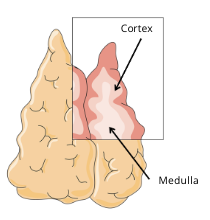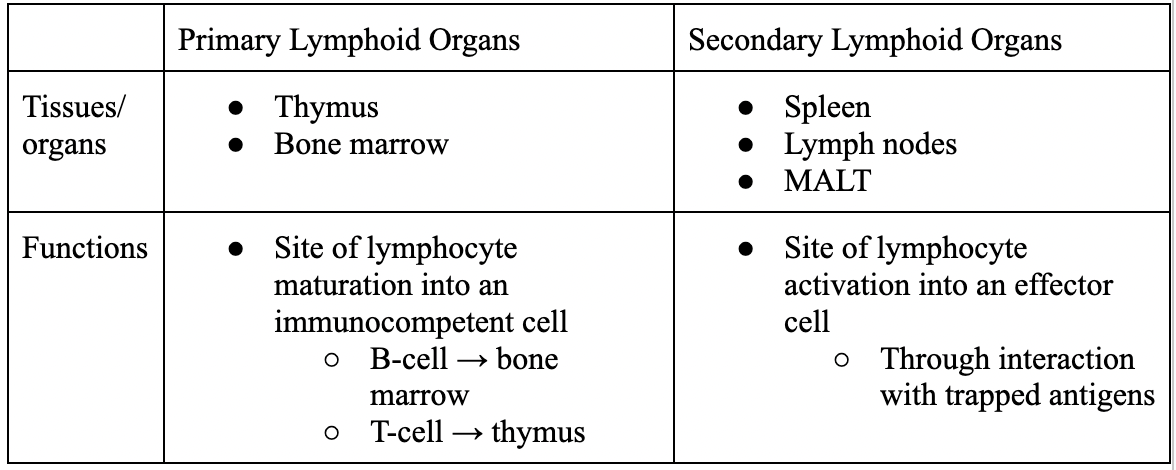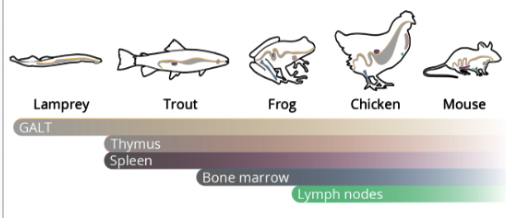MICR 270 Module 1
1/104
There's no tags or description
Looks like no tags are added yet.
Name | Mastery | Learn | Test | Matching | Spaced |
|---|
No study sessions yet.
105 Terms
Commensal
microorganisms that are harmless or beneficial, makes up most of our microbiome
pathogenic
microorganisms that can cause a disease state, make up less of the microbiome
Immune system
organization of cells, tissues and organs within the body that each have their own specialized role in defending against infection
Includes innate and adaptive immune system
Immune response
reaction of immune cells to the presence and actions of microbes or danger signals in the body
What are the 2 functions of the immune system?
Discriminate: recognize self from non-self
Eliminate: destroy non-self (pathogen) and altered self cells (cancer)
What are the 2 possible dysfunctions of the immune system?
Autoimmunity and hypersensitivity: misdirect or overly active immune system (ex; allergies)
Immunodeficiency: underactive immune system (ex; AIDS)
Antigen
foreign protein that induces an immune response, typically including the production of antibodies. (antigen = antibody generator)
Antibody
protein that is produced in response to, and countering, a specific antigen
Antibodies bind to foreign substances (antigens) in the body and provide a signal for their elimination
What is the most important property of the immune system?
Balance is the most important property for the immune system
We don’t want an under or over functioning immune system
Lymphatic system
network of vessels that drain lymph fluid that filtrated from the capillary blood into the interstitial space
often considered part of the circulatory system, but also important in immunity

Lymph
a colourless fluid containing white blood cells that bathes the tissues and drains through the lymphatic system into the bloodstream
B cells and T cells (lymphocytes) are most commonly found in the lymph
Interstitial space
fluid filled areas that surround the cells of a given tissue
Circulatory system
where the lymph comes from and goes after being filtered
Lymphatic vessels
Distributed throughout the body and pick up lymph and carry it towards the heart where it can re-enter the circulatory system. Contain lymph nodes.
Bone marrow structure
Flexible tissue
Divided in two types: yellow and red marrow
Filled with hematopoietic cells
Bone marrow function
Red marrow
Importance for the immune system
Site of hematopoiesis
Site of B-cell development
Yellow marrow
Some leukocyte development
Produces fat and cartilage
Bone marrow location
Central cavity inside the bones
Hematopoietic
cells lodged within bone marrow responsible for producing the cells which circulate in the blood (RBC, WBC, platelets)
Hematopoiesis
the formation and differentiation of blood cells. Origin of all immune cells.
Divided into myeloid and lymphoid
Every immune cell originates from pluripotent hematopoietic stem cells in the fetal liver and bone marrow
Lymph nodes structure
Small (1-25mm)
Bean-shaped
Numerous (~600)
Divided into 3 regions (cortex, paracortex, and medulla)
Filled with lymphocytes, macrophages and dendritic cells
Lymph nodes function
Filters the lymph
Often the first organized lymphoid structure that foreign molecules encounter when entering the body
Lymph nodes location
Grouped along the lymphatic vessels
Lymphocytes
white blood cells which arise from the lymphoid progenitor lineage during hematopoiesis. Generally refers to B- and T-cells
MALT (mucosal associated lymphoid tissue) structure
Combined surface area of various areas in the body including BALT, GALT, lamina propria of intestinal villi, peyer’s patches, tonsils, appendix
Filled with various types of immune cells depending on the location
MALT function
Initiates immune responses to specific antigens encountered along all mucosal surfaces
MALT location
Mucous membranes lining the digestive, respiratory, and urogenital systems
BALT
bronchus-associated lymphoid tissue; lymphoid structure part of the MALT located in lungs and bronchus
GALT
gut-associated lymphoid tissue; lymphoid structure part of the MALT located in the gut
lamina propria of intestinal villi
thin layer of connective tissue rich in immune cells located in the lumen of the small intestine
Peyer’s patches
small masses of lymphatic tissue found throughout the ileum region of the small intestine
Tonsils
collection of lymphoid tissue facing the aerodigestive tract, mainly located into the pharynx
Appendix
small pouch-like sac of tissues located in the first part of the colon in the lower-right abdomen. Harbours bacteria and helps with immune function. Plays a role in establishing the core gut microbiome.
Spleen structure
Large, ovoid
Divided into two compartments: white pulp and red pulp
White pulp is filled with macrophages, lymphocytes, T-cells, B-cells, and red blood cells (more important for immune system)
Red pulp is composed of cords of billroth and splenic sinuses filled with blood
Billroth
fibrils and connective tissue cells with a large population of monocytes and macrophages
Spleen function
Red pulp filters the blood
White pulp is the site of development of immune responses against antigens found in the bloodstream
Spleen location
Left abdominal cavity
Thymus structure
Flat
Bi-lobed; each lobe is divided into lobules which are organized each into two compartments (cortex and medulla)
Filled with thymocytes, epithelial cells, dendritic cells, and macrophages

Thymus function
site of T-cell development and maturation
Thymus location
Situated above the heart
Thymocytes
T-cells found in the thymus
Primary vs secondary lymphoid organs

Discrimination in the immune system
ability of immune cells to distinguish between self and non-self components
MHC I
Major histocompatibility complex Class 1: a molecule on the surface of almost every nucleated cell in the body that presents a sample of the proteins found inside the cell
MHC II
class of MHC molecules present on special cells of the immune system (macrophages, dendrites, B-cells) essential for adaptive immunity to recognize foreign molecules
Elimination, and steps
abilities of immune cells to initiate an immune response. Steps:
Innate immune system
consists of physical, soluble, and cellular barriers that are scattered throughout the body to prevent the entry of any infectious agent and respond non-specifically
Components:
First line of defence against foreign agents
Physical, soluble, and cellular barriers
Functions:
Immediate recognition and response to invading pathogens (minutes or hours)
Recognizes general patterns not specific for any one antigen; limits the type of immune response initiated
Adaptive immune system
consists of cells and soluble components capable of recognizing and responding to specific pathogens
Components
Further divided into antibody-mediated humoral immunity (mediated by B-cell) and cell-mediated immunity (mediated by T-cell)
Functions
Longer time required to initiate a response to invading pathogens (days)
Recognize and responds to specific antigens - wider range of responses possible
Leads to immunological memory - quick response upon second infection
Amebocyte
a mobile cell (moving like an amoeba by pseudopodia) in the body of invertebrates
Oldest cell to have given rise to a part of the immune system (phagocyte)
Pseudopodia
temporary cytoplasm-filled projections of the cell membrane that extend from motile and phagocytosing cells, usually used for motility or ingestion of extracellular components
Phagocytosis
the ingestion of bacteria or other material by phagocytes and amoeboid protozoans
Parsimony
the explanation requiring the fewest assumptions is most likely to be correct, the simplest explanation tends to be the right one
Evolution of the immune system
Almost all vertebrates have GALT
Most vertebrates have some sort of thymus or spleen
Not many vertebrates generate lymphocytes in the bone marrow
Sharks and rays are the earliest organisms with B- and T-cells
Not all vertebrates have lymph nodes (they are a more recent evolutionary trait)
Innate immune systems are found in vertebrates, invertebrates, fruit flies and plants
Adaptive immune systems are only found in subphylum vertebrata (all animals with backbones)
Only more complex organisms within this subphylum have well-developed adaptive immune systems
B-cells and T-cells are only found in jawed vertebrates

Immune system and pregnancy
Immune system is in a state of ‘flux’ (constantly changing) during pregnancy since the baby is 50% foreign DNA
At the beginning many immune cells are recruited to the site of implantation to help with implantation (NK cells, neutrophils, T-cells)
After 12 weeks, the immune system enters a state of immune ‘dampening’
At end of term, immune system changes and is less inflammatory
Pluripotent
cells capable of giving rise to several different cell types
How do B and T cells mature?
B cells reach maturity in bone marrow
T cells travel further to the thymus to complete development
Hematopoietic stem cell (HSC)
every blood cell arises from this, including erythrocytes (RBC), platelets, and leukocytes (WBC). Characteristics:
Self renewal: ability to divide itself to replace older cells, keeping stem cell pool constant
Pluripotent: ability to differentiate into several cell types. Once a stem cell commits to a lineage, it loses the ability of self-renewal and becomes a myeloid or lymphoid progenitor cell
Myeloid lineage
myeloid progenitor cells differentiate into most of the cells of the innate immune system
Myeloid progenitor cells
ability to differentiate into four different groups of myeloid cells, majorly innate immune system cells.
Granulocyte
Neutrophil
Eosinophil
Basophil
Mast cell
Monocyte
Macrophage
Erythrocyte (red blood cell)
Thrombocyte (platelet)
Platelets
central contributor to the process of coagulation, wound healing, and fibrinolysis
Have inflammatory functions that influence innate and adaptive immune response
Intervene against microbial threats
Recruit and promote innate effector cell functions
Moderate antigen presentation
Enhance adaptive immune responses
Monocytes
type of phagocyte located in the blood that are able to travel outside of the circulatory system by moving across the blood vessel walls. When they penetrate tissue they become macrophages and undergo changes:
Get bigger
Increase of number and complexity of intracellular structures (pseudopodia, phagosome, lysosome)
Acquire better phagocytic abilities
Phagosome
vacuole in the cytoplasm of a cell containing phagocytosed particles enclosed within a part of the cell membrane
Lysosome
vacuole containing enzymes that digest particles; when fused with a phagosome it is called a phagolysosome
Granulocytes
group of WBC characterized by secretory granules in their cytoplasm
Mast cells
AKA granulocytes: located in the tissues with large granules containing histamine and other active substances. Function similar to basophil and are involved in allergy development.
Neutrophil
Abundant leukocyte that has characteristics of granulocytes and phagocytes
Granulocyte characteristics: have a polymorphic nucleus and granules containing lytic enzymes (peroxidase, lysozyme, etc) which aid in infectious agent elimination
Phagocytic characteristics: have the ability to engulf and absorb (kill) bacteria
Neutrophil are first to arrive at inflammation site
Lifespan of a few days
Polymorphic nucleus
a cell nucleus that assumes an irregular form or splits into completely separated lobes
Peroxidase
enzyme that catalyzes the oxidation of substrates by hydrogen peroxidase
Lysozyme
an enzyme that catalyzes the destruction of the cell walls of certain bacteria
Basophil
non-phagocytic granulocytes with the largest granules and least common type of granulocyte.
Granulocyte characteristics: polymorphic nucleus, granules containing active substances (heparin, histamine)
Function similar to mast cells (allergy development)
Heparin
a compound that inhibits coagulation
Eosinophil
phagocytic granulocytes
Granulocyte characteristic: polymorphic nucleus, granules able to damage parasitic membranes
Phagocytic characteristic: very minor role
Play a role in defence against multicellular parasites like helminths
Lymphoid lineage
lymphoid progenitor cells differentiate into the cells that make up most of the adaptive immune system (lymphocytes; B and T-cells)
Lymphoid progenitor cells
ability to differentiate into two major type of cells of adaptive immune system (B and T-cells) as well as Natural Killer cells
B-cell
Plasmocyte (effector B-cell)
Memory B-cell
T-cell
Helper T-cell (CD4+ T cell)
Cytotoxic T-cell (CD8+ T cell)
Memory T-cell
Natural killer cells (NK cells)
granular lymphocytes with granules which contain perforin and granzymes
Ability to recognize tumour or virus-infected cells despite lacking antigen-specific receptors (distinguish abnormal cells and destroy them)
Exception for lymphoids because they do innate immunity
Perforin
a protein released by cytoplasmic granules that destroys target cells by creating lesions like pores in their membranes
Granzymes
proteases released by cytoplasmic granules that induce programmed cell death in the target cells
T-cells (T lymphocytes)
non phagocytic cells that have specific receptors at their cell surface called T-cell receptors (TCR)
key to cell-mediated immunity
T-cells mature in the ‘T’hymus
Specificity: one T-cell expresses many TCR that recognize the same specific antigen or epitope
Diversity: every T-cell in the body recognizes a different antigen through their TCR specificity
Helper T-cells (Th cells)
specialized T-cells that express CD4 costimulatory molecule on their cell surface
Activated when they recognize an antigen-MHC class II complex
Effector cells: helper T-cells play a key role in the activation of other immune cells
Memory cells: recognize the same specific antigen, quick and strong response to reinfection of the same pathogen
Cytotoxic T-cells (Tc or CTL)
specialized T-cells that express the CD8 co-stimulatory molecule on their cell surface
Activated when they recognize an antigen-MHC class I complex
Effector cells: cytotoxic T-cells monitor the cells of the body and eliminate any cells that display a foreign antigen complexed with MHC class I
Memory cells: CD8+ generate memory cells that recognize the same specific antigen
B-cell (B lymphocyte)
non-phagocytic cells that have specific receptors at their cell surface called B-cell receptor (BCR), which are the membrane bound form of antibodies
Key to humoral immunity
B cells mature in the ‘B’one marrow
Specificity: one B-cell expresses many BCR that recognize the same specific antigen (epitope)
Diversity: every B-cell in the body recognizes a different antigen via BCR specificity
Plasmocytes (plasma cells)
effector form of activated naive B-cells that produce and secrete highly specialized antibodies that can bind free pathogens or foreign molecules in the organism
Activation of B-cells can also generate memory B-cells that have membrane-bound antibodies (BCR) with the same specificity as the mother cell
Naive
Immunocompetent (mature) cells are considered ‘naive’ until they interact with a foreign antigen for the first time
Dendritic cells (DC)
phagocyte that can arise from either the myeloid or the lymphoid progenitor cells, part of both innate and adaptive immunity.
Function to capture and engulf antigens that evade innate immune response and present them to adaptive immune cells
DC are the link between innate and adaptive immune systems
Langerhans DC
subtype of DC located under the surface epithelium of the skin and in mucous membranes
Overview of immune cells
History of immunology
1796: smallpox vaccine via cross-immunity(Edward Jenner)
Milkmaids that had cowpox were immune to smallpox
Pasteurization: using heat to destroy pathogens to prevent spoilage (Louis Pasteur)
Vaccination: attenuated form of a virus leads to immunity (Louis Pasteur)
1890’s: complement system (network of proteins that defend against pathogens) was discovered in 1890 (many scientists)
1908: nobel prize
Elie Metchnikoff : phagocytic theory that cells can move in order to defend against bacterial infection
Paul Ehrlich: humoral immunity, side-chain theory, blood transfusion as treatment
1913: Charles Richet nobel prize for discovery of anaphylaxis (hypersensitive reaction)
1972: nobel prize Rodney Porter and Gerald Edelman for the structure of antibodies
1987: Susumu Tonegawa nobel prize for mechanism of antibody variety generation
2011: Jules Hoffman and Bruce Beutler nobel prize for discovery of toll-like receptors
Cross-immunity
form of immunity in which immunity to one bacteria or virus is effective in protecting against an antigenically similar, but different organism
Attenuated
less pathogenic form
Bactericidal
able to kill bacteria
Lipopolysaccharides
large molecules found on the outer membrane of gram-negative bacteria; elicit strong immune responses
What are the 6 major classes of infectious disease-causing agents
bacteria
viruses
fungi
protozoa
helminths
prions
Bacteria
unicellular prokaryotic organisms with no organized internal membranous structures. Genomes are circular double-stranded DNA that do not code for as many proteins as eukaryotic genomes.
Cholera
Acute diarrheal illness caused by infection of the intestine by bacterium Vibrio Cholerae
Usually mild, but 1 in 10 has severe disease (profuse diarrhea, vomiting, and leg cramps)
Contracted by eating or drinking contaminated food
Diagnosed by stool sample and rectal swab
Viruses
not considered ‘organism’ because it relies on host cell for metabolism and reproduction
Composed of a viral genome of nucleic acid (DNA or RNA) which can be double or single stranded, that is surrounded by a protein coat (capsid)
Can also have an outer lipid envelope
Influenza
Contagious respiratory virus which varies in severity
Fever, cough, sore throat, runny nose, body aches, headaches
Spread via droplets of saliva
Diagnosed by lab tests
Fungi
eukaryotic, heterotrophic organisms that have rigid cellulose or chitin-based cell walls and reproduce by forming spores which cause skin or lung infection
Divided into molds (multicellular) and yeast (single celled organisms)
Vaginal yeast infection (vulvovaginal candidiasis VVC)
Overgrowth of the yeast candida in vagina
Causes genital itching
Imbalance of immune system allows candida to multiply
Visual examination and lab testing of cell sample
Antifungal cream, ointment, tablets, or suppository
Protozoa
unicellular, heterotrophic eukaryotes without cell walls, allowing for rapid and flexible movements
Malaria
Mosquito-borne disease caused by a protozoan parasite in the palmodium genus
Fever, chills, flu-like illness, death
Helminths
parasitic worms; simple invertebrates which are multicellular with differentiated tissues